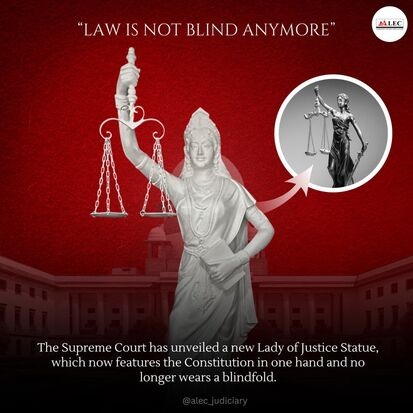The Supreme Court of India has unveiled a redesigned version of the iconic 'Lady Justice' statue, signaling a transformative step in the judicial outlook of the country. Traditionally it is associated with impartiality as reflected through its depiction of having a blindfolded woman holding scales and a sword,however, the new statue now reflects modern values by featuring open eyes and holding the Constitution of India. This change, led by Chief Justice of India (CJI) D.Y. Chandrachud, underscores the judiciary's evolving identity—i.e. one rooted in constitutional principles and vigilance rather than colonial-era symbolism.
In this blog, we delve into the symbolism behind the redesign, its alignment with India's broader legal reforms, and the message it conveys for the future of justice in the country.
Table of Contents
- A Symbolic Shift: Open Eyes and Equality
- The Constitution Replaces the Sword
- Breaking Free from Colonial Legacy
- Retaining the Scales of Justice
- Conclusion: A Justice System That Sees All Equally
1. A Symbolic Shift: Open Eyes and Equality
One of the most striking elements of the redesign is the removal of the blindfold from 'Lady Justice.' Traditionally, the blindfold has represented impartiality, suggesting that justice must be delivered without prejudice. However, the Supreme Court's new interpretation challenges this symbolism by embracing a justice system with open eyes—one that sees every individual clearly and fairly.
Chief Justice Chandrachud emphasized this new philosophy, stating, “The law is not blind; it sees everyone equally.” The removal of the blindfold signifies the Indian judiciary’s conscious decision to distance itself from outdated ideals and reflect a more inclusive, vigilant, and aware justice system.
This bold redesign reflects an acknowledgment that justice, in a modern democracy, must not be blind to the context, social realities, or individual circumstances. By keeping its eyes open, the judiciary demonstrates its commitment to fairness that goes beyond impartiality, actively ensuring equality for all.
2. The Constitution Replaces the Sword
Another significant change in the new statue is the replacement of the sword with the Constitution of India. In its previous form, the sword symbolized authority, power, and punishment—elements aligned with a justice system focused on retribution. The new approach, however, shifts the focus towards upholding constitutional values and principles.
The Constitution, held firmly in Lady Justice’s hand, represents the judiciary’s foundational role in protecting citizens' rights and ensuring equality before the law. It sends a clear message: justice is no longer about delivering punishment but about safeguarding fairness, equality, and the rule of law.
A senior official from the Chief Justice’s office explained, “The sword is a symbol of violence, but courts deliver justice according to constitutional laws. The new statue aims to reflect this principle.”
This change aligns with the judiciary’s evolving mission to promote constitutional justice over mere authority, ensuring that legal decisions prioritize human rights and freedoms.
3. Breaking Free from Colonial Legacy
The redesign of 'Lady Justice' is part of a broader movement within the Indian judiciary to shed its colonial heritage. In recent years, several legal reforms have reflected this shift, including the introduction of the Bharatiya Nyaya Sanhita (BNS) to replace the Indian Penal Code (IPC)—a law that dates back to British rule.
Chief Justice Chandrachud has always been vocal about the need to leave behind British-era symbols and laws, asserting that the judiciary's role is not just to punish but to protect the rights and dignity of every citizen. The new 'Lady Justice' statue embodies this ideology by placing the Constitution at the center of its design.
“Justice Chandrachud believes that India should move forward from the British legacy, and that the law is never blind; it sees everyone equally,” noted a source close to the Chief Justice. This reimagined statue stands as a symbol of a progressive justice system that reflects India’s own values and aspirations.
4. Retaining the Scales of Justice
While several elements of the original statue have been reimagined, the scales in Lady Justice’s right hand remain unchanged. These scales represent the delicate balance of justice—the impartial weighing of evidence and arguments to arrive at a fair verdict.
The scales are a timeless reminder that justice must consider both sides before making a decision, ensuring fairness for all parties involved. An official explained, “The scales of justice represent balance in society, and the idea that facts and arguments by both sides are weighed by courts before arriving at a conclusion.”
This enduring element reflects the judiciary's commitment to maintaining balance in its pursuit of justice, regardless of how other symbols may evolve.
5.Conclusion: A Justice System That Sees All Equally
The redesigned 'Lady Justice' statue in the Supreme Court of India marks a pivotal moment in the country’s legal history. With open eyes replacing the traditional blindfold and the Constitution replacing the sword, the statue symbolizes a shift towards a more aware, inclusive, and principled justice system. It reflects the judiciary's ongoing effort to align itself with constitutional values and break free from colonial legacies.
As India progresses, its justice system must continue to evolve—embracing modern ideals while retaining the core principles that define fairness and equality. The new statue serves as a powerful reminder that justice is not just a distant ideal but an active force that sees and protects all individuals equally.
With this symbolic transformation, the Supreme Court sends a clear message: justice in India is no longer blind—it is vigilant, inclusive, and firmly rooted in the principles of the Constitution.
This reimagining of Lady Justice invites citizens to view the judiciary as more than just an institution of law but as a guardian of fairness, human dignity, and constitutional rights. As the judiciary evolves, so too must our understanding of justice, ensuring it remains a force that truly sees and serves everyone.
You can also read the latest judgment by visiting [Latest Judgment].
For more information, visit [ALEC Enquiry].

